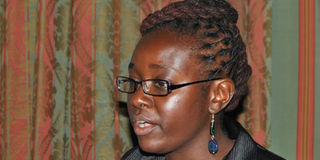Lobbies raise red flag over hotspot counties

Creco’s Acting Programme Coordinator Regina Opondo addresses participants during a breakfast meeting to launch a report on conflict mapping and profiles of 47 counties ahead of the next elections May, 2 2012 ANTHONY OMUYA
Lobby groups have identified 24 counties as possible violence hotspots as the country prepares for the next General Election.
In a report launched Wednesday, the groups identified the areas as Marsabit, Isiolo, Mandera, Wajir, Narok, Garissa, Tana River, Mombasa, Kwale, Kilifi, Nairobi, Trans Nzoia, Nyamira, Migori, Bomet, Kiambu, Uasin Gishu, Turkana, West Pokot, Laikipia, Nakuru, Kisumu, Bongoma and Kirinyaga.
The report on conflict mapping and profiles of 47 counties however urges Kenyans to remain vigilant to avert a repeat of what occurred after the 2007 elections.
It was prepared by the Constitution and Reform Education Consortium (Creco) and the Elections observation Group (Elog).
Some 1,133 people lost their lives and a further 650,000 were displaced in the post-election violence.
While releasing the report, the lobby groups expressed worry that of the 47 counties, only four were categorised as low risk areas.
They are Embu, Machakos, Vihiga and Siaya counties with the remaining 19 being categorized as medium risk areas.
“It is sad that at least 80 percent of all the 47 counties have the potential for violence. These areas need adequate monitoring,” said Ms Regina Opondo, Creco’s Acting Programme Coordinator.
“Relevant state organs must ensure that there are pro-active approaches (including early warning systems) to ensure that conflict in these Counties is managed and is not allowed to escalate as happened in 2007,” she said.
Elog chairman Kennedy Masime likened the violence hotspot areas to those living in timber houses.
“The houses can catch fire at any time…preventive measures should be taken to ensure that this does not happen,” he said.
“Some of the issues that have been identified as the main causes of possible violence in these areas have been with us for a long time. They will perhaps take us long to resolve. We must in the meantime look for short term solutions to ensure that violence does not erupt again,” he said.
In Mombasa County for instance, the report says that due to its cosmopolitan nature, active presence of secessionist group (like the Mombasa Republican Council), long history of post-election violence and persistent land problem, the chances of electoral violence erupting was very high.
Nairobi County, the report says, is a very high conflict risk area owing to its political significance in the country, the entrenched culture of political violence, scars of the post-election violence and prevalence of social tensions associated with inequality, youth unemployment and landlessness.
In Garissa County, the report says the presence of refugees in Daadab, deteriorating border situation in Somalia, religious intolerance and resource based conflicts are key factors that might affect the electoral environment in the run-up to the elections.
Kiambu County has been categorised as a high risk area with likely hotspots being Kiambaa, Lari, Gatundu and Juja due to rising intolerance against politicians opposed to Deputy Prime Minister Uhuru Kenyatta and their supporters.
“The Mungiki issue is also likely to be a destabilising factor if members of the sect are mobilised for nefarious purposes. The County therefore merits closer scrutiny,” say the report.
In Narok County, the lobby groups say the border areas between Kilgoris in Narok County and Kisii County and Narok North should be monitored because the land question is yet to be resolved.




